National Liberation Front, The elusive Mail of the Ho Chi Minh Trail;
In 1956/1957 a first resistance movement for South Vietnam was founded and on December 20th, 1960 the National Liberation Front for the Liberation of South Vietnam was formally declared. Being a guerrilla army it operated in a clandestine fashion. A large number of the rural population, that was no fan of the Ngo Dinh Diem and Nguyễn Văn Thiệu Governments, were recruited as a voluntary force to assist professional fighters located in the South. These included men, women and children. While younger men worked as farmers during the day they became soldiers at night. Older men were often forced into carriage work in order to deliver food stuff, weapons and ammunition. Women were engaged to carry out household duties and act as medics but their work also included assassinations of enemy soldiers. Children were used as look-outs that could send out alarms to the fighting force. Of course the entire country population also provided the food that was needed to feed the troops and resources (Including opium) to trade for weapons.
As of 1950, most of the Viet Minh, and by extension, the National Liberation Front (NLF) support in the shape of weapons, ammunition and fuel came from the Peoples Republic of China. The Soviet Union only became important in the mid 1960’s. Of course, men and these materials had to be transported to the South. The primary routes to make these deliveries were the Cambodian and Laos land corridor, ocean shipments into Cambodia and infiltration along the Eastern Coast of South Vietnam. Here is a map produced by the U.S. Army during the Viet Nam War that shows the primary infiltration routes into South Vietnam.
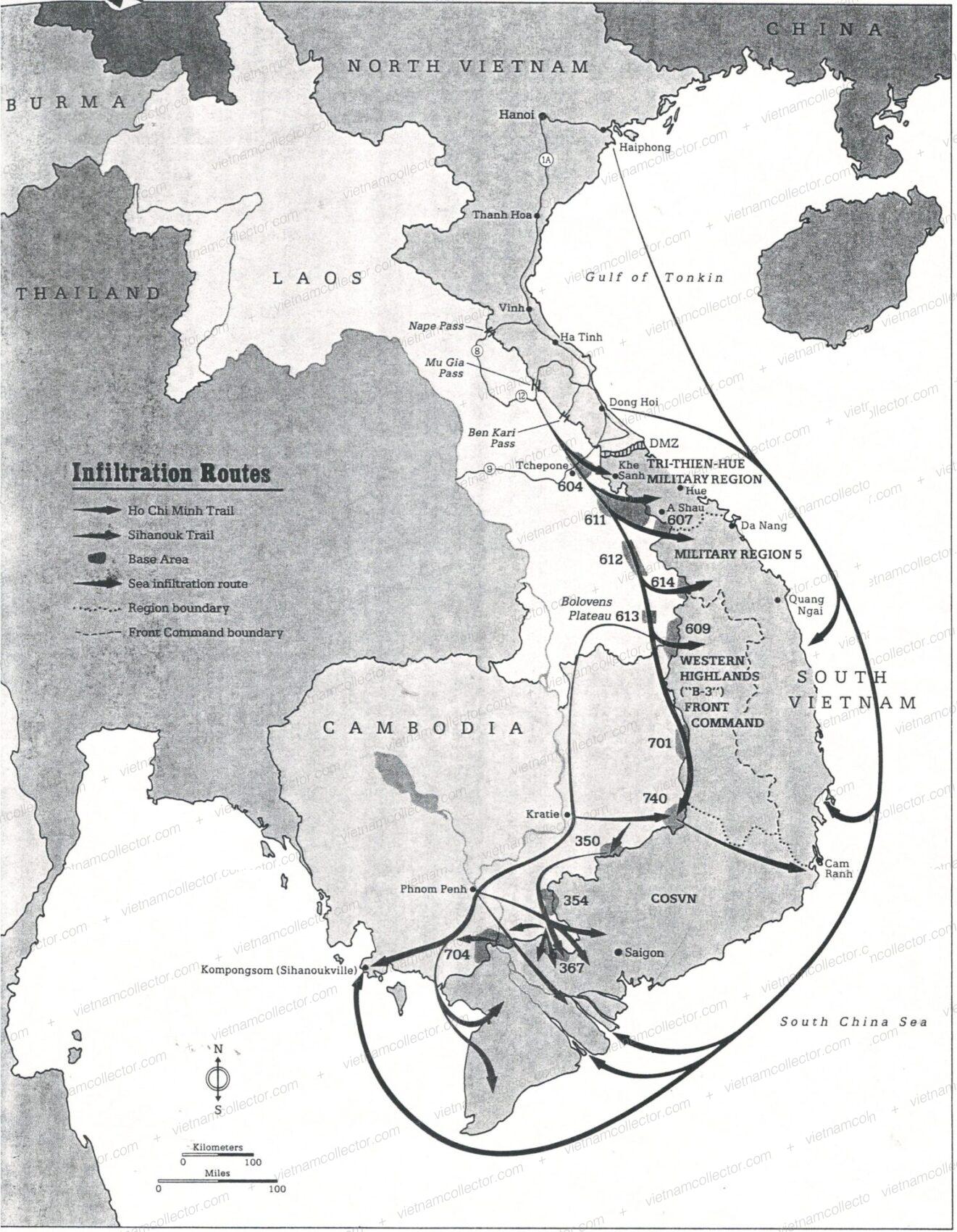
The Cambodian corridor was eventually closed when American forces invaded the country and the Ocean shipments were also heavily curtailed but the Laos corridor remained open throughout the war and hence became the most important and connection between North and South. Here Tchepone (today Xepon) in Laos became a key town were North Vietnamese activity was very concentrated and was an important part of the Ho Chi Minh Trail. It was the first major North Vietnamese base coming from the North. Most of the information regarding the Ho Chi Minh Trail (including the HCM Trail map below) was obtained from the book “The War for the Ho Chi Minh Trail” by the U.S. Army Command and General Staff College.
The Ho Chi Minh Trail had its beginnings already during World War II and the First Indochinese War with the French but was greatly improved over time. Already in 1959 the Government of North Vietnam created a transportation group (Nr. 559) that was charged to create transportation routes in Laos and operate the Ho Chi Minh Trail. The group employed around 100,000 people at any given time during the war. One has to imagine the HCM Trail not as a single road but as a road network that consisted of the transportation arteries in the North then moved West into Laos and further South turned East into South Vietnam or Cambodia. Initially, the trail was exactly that, a network of foot paths on which people walked on foot or pushed bikes, but these trails were followed by dirt roads that allowed for the movement of automobiles and trucks. By 1965 the road system was in the position to accommodate heavy equipment and supplies. This included T-34 and T-54 tanks, ZU 23 and SA-2 antiaircraft weapons and heavy artillery pieces. According to North Vietnamese figures over 2 million men and 45 million tons of supplies were transported on the trail during the course of the war. Of course the terrain was still very difficult with a lot of mountainous regions and many river and stream crossings and so connectivity very much depended on the weather. During the wet season, when roads were muddy and soft, traffic was often restricted to foot traffic. This improved over time as the Transportation Group 559 made the “Trail” eventually all weather proof allowing the movement of trucks even during the rainy season. According to North Vietnamese claims the HCM Trail encompassed as much as 16,000km (or 10,000 miles) of road and thousands of kilometers of fuel pipelines. Road construction encompassed about 450 kilometers per year beginning in 1965 and amounted to almost 1,000 kilometers in the years 1970-71. 3,000 kilometers of the road system also were camouflaged providing some protection from aerial bombings. Nevertheless, heavy bombing by the American Air Force continually interrupted the roads in Cambodia and Laos but the North Vietnamese had built a grid system that allowed for quick lateral movement of convoys to other roads that were still passable while the damage was repaired. This meant that the HCM Trail was rarely ever completely disrupted.

Viet Cong Paper Map used for propaganda purposes

In order to convince the population in the South that Ho Chi Minh was the better leader for the country small leaflets were distributed among the rural population that featured quotes by him:


The Viet Cong also distributed “Free Conduct Passes” in order to convince ARVN soldiers to change colors and desert.


Of course U.S. troops were not to be outgunned in the Psych-Ops realm and they in turn produced small propaganda cards printed on cardboard paper that were distributed during “search and destroy operations” to the Vietnamese population. The intend was to undermine the morale of the Viet Cong soldiers that were embedded within the population at large.
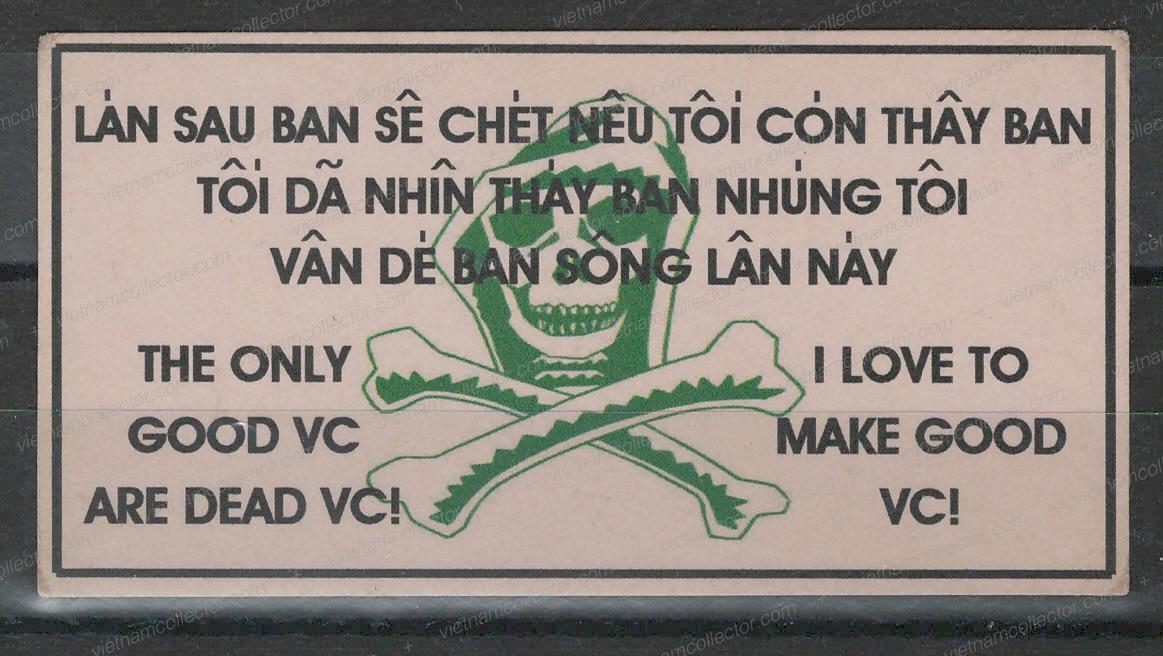
The Vietnamese inscription does not resemble the English inscription. In fact it states: “The next time you will die, when I see you again. I have seen you but this time I will let you live”.
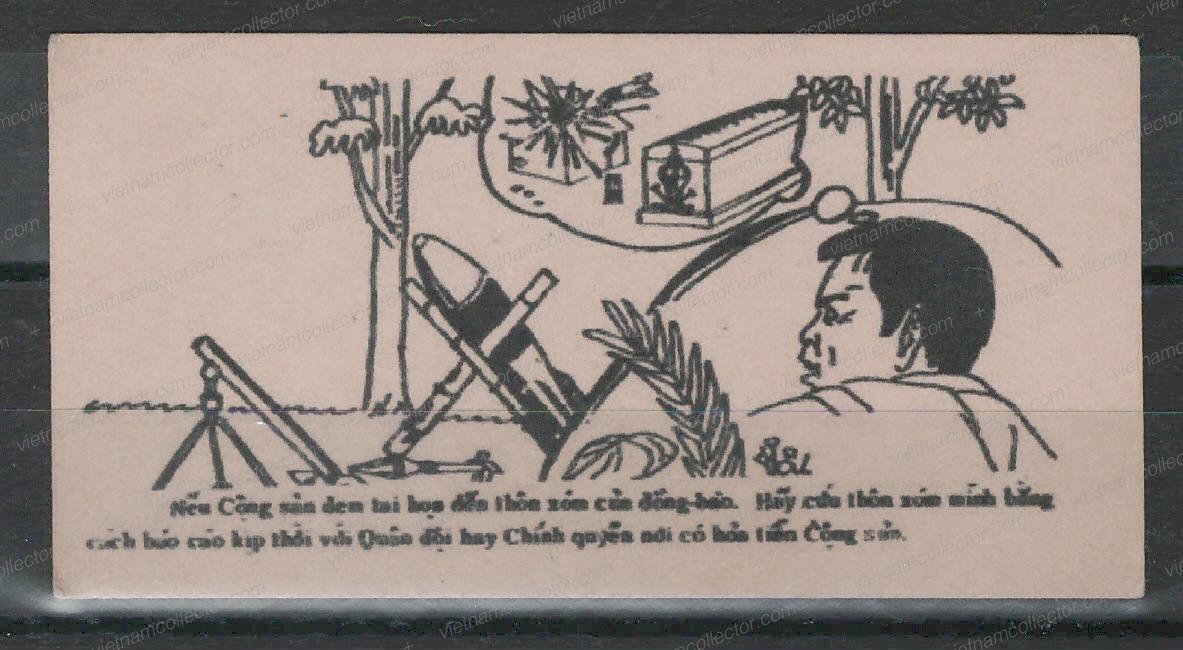
The Vietnamese inscription translates into: “When communist bring dangers to your villages, save your villages by informing the army or the administration of the location of communist rockets”.
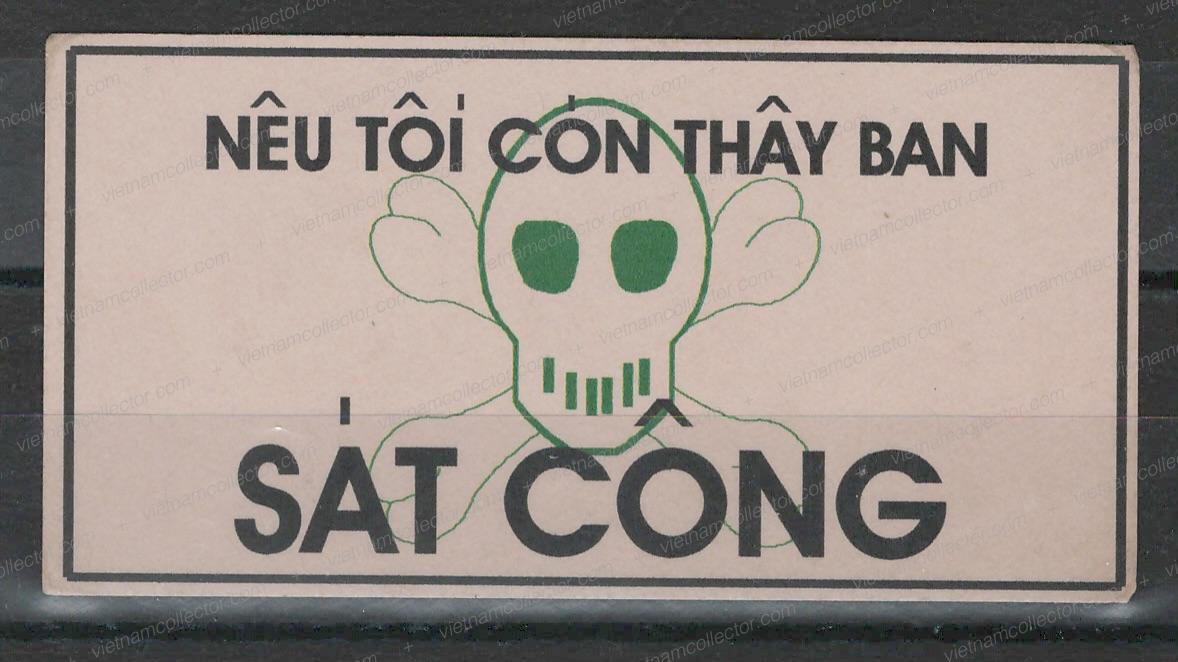
The Vietnamese inscription translates as follows: If I still see you, kill communists”.
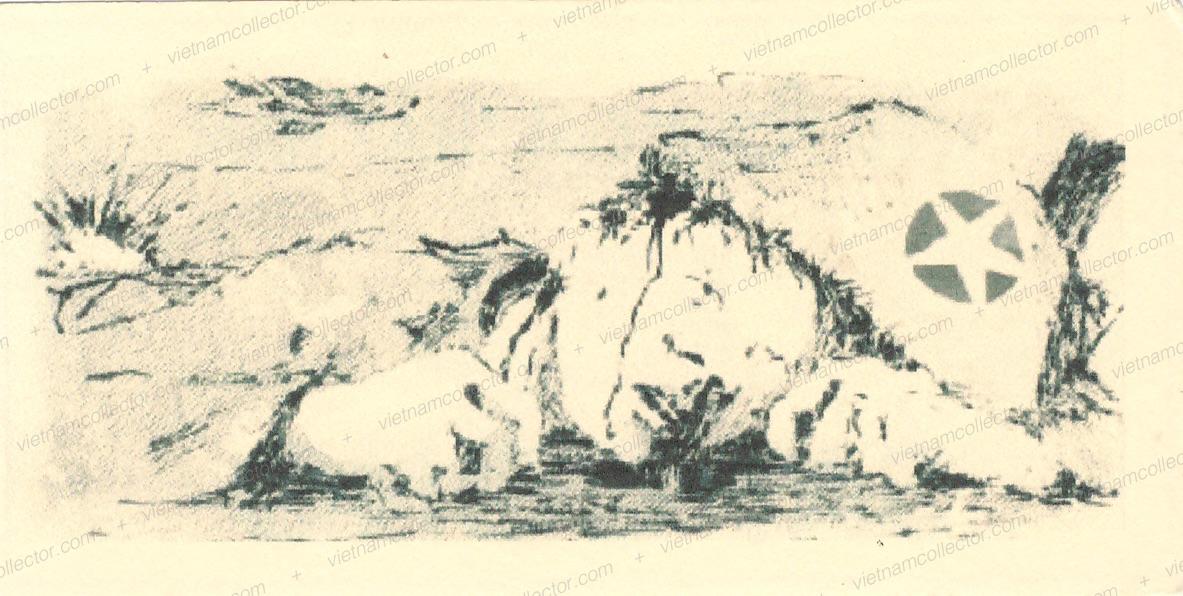
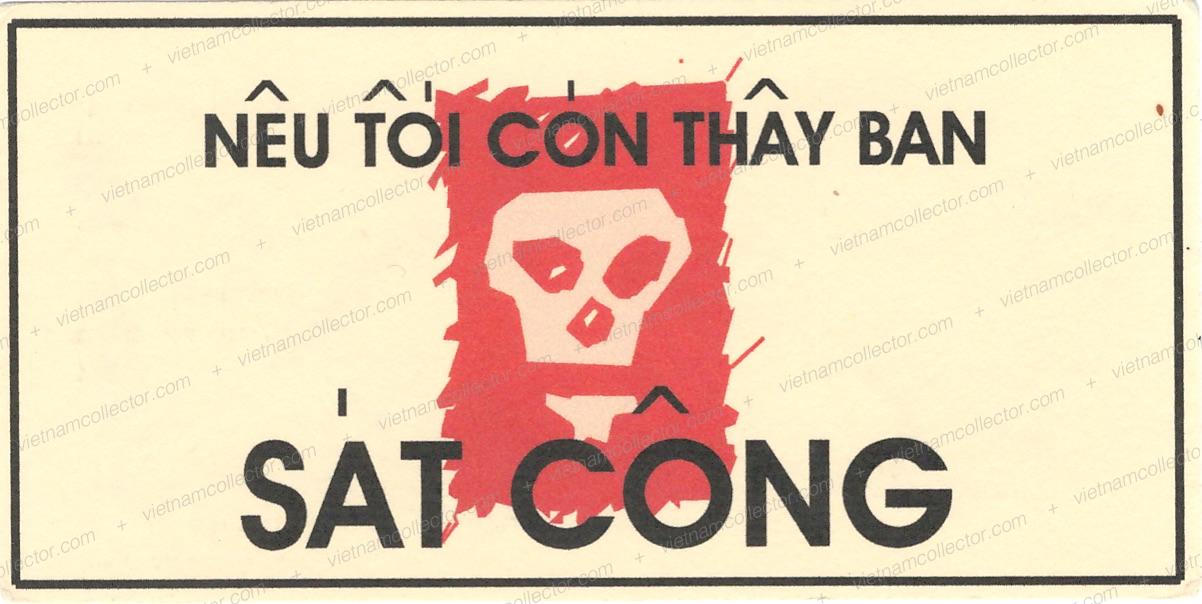
The Vietnamese inscription reads “The crime of the assassins”.
Below is a map of South Vietnam that shows the Viet Cong administrative districts or tactical zones (ex Joe Cartefalsa, SICP). These tactical zones were called Hom Thu and they identified a military unit. A Hom Thu of 7 would hence indicate a unit located in the Saigon region. On a personal basis every soldier also received a Hop Thu number which was essentially their own personal identifying code that was used in sending and receiving mail.
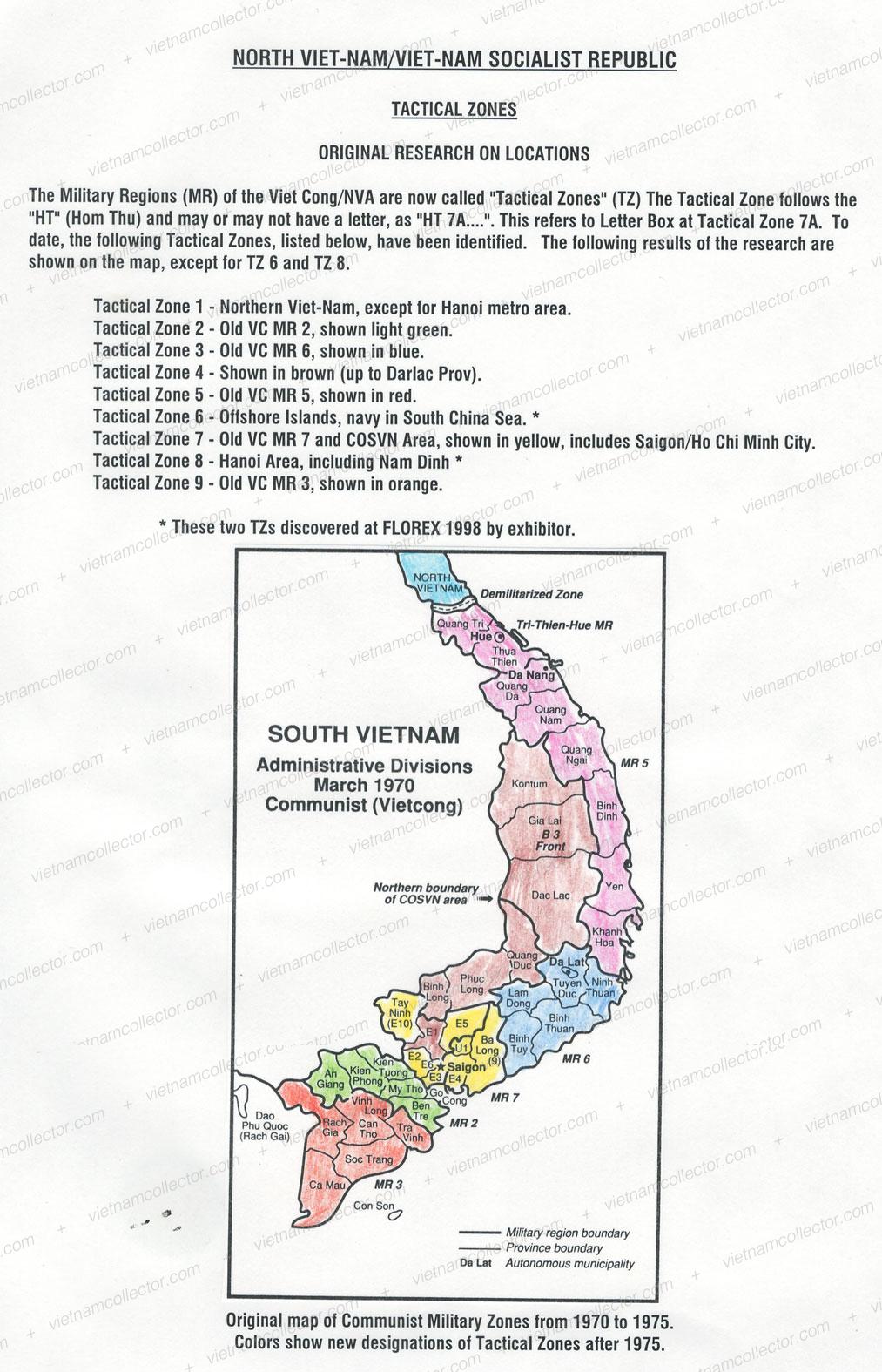
Most of the mail was transmitted from North to South as naturally, dependant’s of soldiers wanted to stay in contact with their loved ones. Mail from South to North was possible but was officially discouraged in order to avoid discouraging news being disseminated among the Northern populace. North-South Mail included military and political messaging among military units and personal messages sent by dependents of soldiers. Personal mail had to be sent using two envelopes. One envelope, that actually contained the ultimate letter (on which only the name and Hop Thu number was indicated), had to be sent to a central mail processing facility of the Committee for South Vietnam (COSVN), where the outside envelope was removed and the letter inside was then transferred by couriers to their ultimate destination in the South. This was also one of the reasons why true trail mail was mostly contained in small, homemade envelopes that were fashioned of recycled paper.
Sketch of a NLF fighter in the field writing letter (published by the Liberation Publishing House)

Here is a schematic that was produced by Robert Mushower, who for a long time was a key collector of Ho Chi Minh Trail mail, and that describes the routing of mail once it had passed through the COSVN. Most of the postal history in the editors collection are ex Munshower. Robert was a military police officer in Vietnam.

Ho Chi Minh Trail mail is exceedingly rare. The main reasons for this are that stringent military security requirements mandated that all mail be destroyed immediately after reading and upon receipt. This means the only mail that survived the ravages of war, time and climate was mail that was obtained by enemy interception or mail that was kept by recipients in the North (it is not clear to the editor if the mandatory destruction order in force within the military also extended to civilian recipients). Interception is, of course, a nice synonym of describing the killing of mail couriers who carried the letters in leather pouches or wrapped around their bodies in plastic wrap or cloth to protect them from moisture. This sometimes left traces on the mail itself.
Below is a very plain looking envelope (ex Cartafalsa, ex Dykhouse) that was addressed to Tactical Zone 5 (the coastal area of South Vietnam) which was obtained by an American GI by killing the courier. At the top left the cover shows a 5.56mm hole along with blood stains that was made by his M-16 rifle. Cartafalsa describes that it took him more than 5 years to convince the GI to let the letter go, which he had tucked away for more than 30 years and for him was a very personal part of history. Technically speaking GI’s were mandated to pass on all mail to intelligence officers for further analysis and ultimate destruction but sometimes a GI would keep an envelope or letter as a souvenir.

Up to 1965, the National Liberation Front on the South consisted primarily of 40,000 former Southerners that had moved North and ultimately returned to the South to fight for liberation. Additional North Vietnamese soldiers were deployed after the TET Offensive in 1968. This continued as the war went on and by 1972 up to 80% of the soldiers fighting in the South were actually deployed from North Vietnam by using the Ho Chi Minh Trail.
Anti Aircraft Gunners on a NLF sketch published by the Liberation Printning House

The Viet Cong (VC) and the North Vietnamese Army (NVA) had an elaborate system to support both personal and official correspondence. It was simple, effective, and applied stringent security practices to help ensure secrecy. Here is a typical postal system set up (as described by the late Joe Cartafalsa) that was replicated in each Province in South Vietnam:
Common Section: Chief and Assistant, Political Officer (in charge of censure), two Liaison Agents.
Mail Section: Three Clerks
Postal Route Section: 10-15 Runners plus security guard squad.
Flash (urgent) Message Section : 9-10 people
Food production Section: 3 people
Medic & Foster Sisters Section: 4 Women
Mail distribution ran from the province level down to each district with mail handling stations at each. The district station, in charge of mail distribution, received mail from the postal route courier, sorted it and forwarded it as either ordinary or flash mail. Joe Cartafalsa recounts a statement from a captured NVA Military Postal Lieutenant:
“In the South, the hamlets would send letters to the village, than the village to the district; the district would send them from one station to another and the letters were very liable to be mislaid or get lost. The letters the soldiers sent back to our family were in the same situation., going from the unit to the regiment, then from the regiment to the division, then they would be sent back to hamlets or villages where our families stayed…. To send letters to the North we sent our letters according to a special fixed route. For example to Kontum, from Kontum to Quang Ngai, from Quang Ngai to Quang Nam, to Thua Thiet, then Laos (then north on the Ho Chi Minh Trail and the reverse when going from North to South”
Here are two pages of the only Vietcong Mail Courier Receipt Book that was preserved. The book is from a VC postal unit Unit in Binh Duong, Tay Ninh Province and Dei Giao Lien a liaison unit. Each page in the booklet records the date, mail box code and signature of recipient or sender. 245 letters in total were recorded in this book between June 1st, 1966 and September 15th, 1966. The booklet which was previously owned by Robert Munshower (ex MP in Vietnam) but was divided up by him into three parts and sold on. The largest part ended up in the former Telep collection with the other parts being in the Crenshaw and the editors collection.

Provincial mail service headquarters was usually in the jungle while other sections were located in villages throughout the Province. Mail was addressed between individuals and/or agents through the use of “Hom Thu” or letter boxes. Letter box numbers assigned were numerical or alphanumerical and were changed when the postal communications officer believed a location had been compromised. Below is fairly pristine cover, all things considered (ex Cartafalsa) . The small size is normal as the letters were wrapped in small bundles of cloth or plastic and tied around the waist. The number pointed at by the red arrow is the Hom Thu number, the blue circle with an initial is the mark of the censor and the circled red “K” (Type VII) means “Kin” or secret/confidential. No postal cancels were employed.
Front

Reverse
 For messaging security, mail was transported by hand on trails that were separate from those that carried supplies. The mail was one of the most secretive and secure operations of the communist Government.
For messaging security, mail was transported by hand on trails that were separate from those that carried supplies. The mail was one of the most secretive and secure operations of the communist Government.
Letter (ex Cartafalsa) sent around March 24th, 1968 by a member of a NVA unit in the South addressed to the senders father in Ha Tinh, North Vietnam. The letter was not censored but marked with a circled “K” hand stamp (Type X) denoting “secret” mail.
 Letter contents. Note the manuscript remark of the American GI on the reverse of the letter “II Crops taken from body 17 May 68”. “Crops” was actually misspelled. The GI meant “Corps. South Vietnam was divided into four military regions or “Corps: The letters 1-4 were used by the South Vietnamese to denote the regions while Americans used roman numerals I-IV.
Letter contents. Note the manuscript remark of the American GI on the reverse of the letter “II Crops taken from body 17 May 68”. “Crops” was actually misspelled. The GI meant “Corps. South Vietnam was divided into four military regions or “Corps: The letters 1-4 were used by the South Vietnamese to denote the regions while Americans used roman numerals I-IV.
 This map shows the the military region II in orange. The red arrow denotes where the cover was captured.
This map shows the the military region II in orange. The red arrow denotes where the cover was captured. 
Bob Munshower and Daniel Telep compiled information on the variations of the “K” markings and published the following table in the SICP Journal Nr. 219 (September, 2015):
 “BAO DAM” means “secured” or “warranted” (not registered). The labels were used on mail from the “Flash” or “Urgent” section of the provincial command structure of the Viet Cong military postal system. The letter below (ex Cartafalsa) was sent around July 28th, 1968 by a high level command individual to another. This is shown by the two digit address number and the fact that there is no “HT” routing. No censorship was applied. The letter is from a female leader to a male leader in the Viet Cong command structure. Most of the letter is personal, however, she mentions the upcoming “rising up to drive the aggressor from our land” which is a reference to the January, 1968 TET Offensive intended to capture all of South Vietnam. The TET Offensive ended in September of 1968 or two months after this letter was written.This is one of two known covers that carry a “Bao Dam” label. The other is contained in the former Telep collection. Given that covers with this label were supposed to be destroyed after reading it is no surprise that only two survived the ravages of time.
“BAO DAM” means “secured” or “warranted” (not registered). The labels were used on mail from the “Flash” or “Urgent” section of the provincial command structure of the Viet Cong military postal system. The letter below (ex Cartafalsa) was sent around July 28th, 1968 by a high level command individual to another. This is shown by the two digit address number and the fact that there is no “HT” routing. No censorship was applied. The letter is from a female leader to a male leader in the Viet Cong command structure. Most of the letter is personal, however, she mentions the upcoming “rising up to drive the aggressor from our land” which is a reference to the January, 1968 TET Offensive intended to capture all of South Vietnam. The TET Offensive ended in September of 1968 or two months after this letter was written.This is one of two known covers that carry a “Bao Dam” label. The other is contained in the former Telep collection. Given that covers with this label were supposed to be destroyed after reading it is no surprise that only two survived the ravages of time.
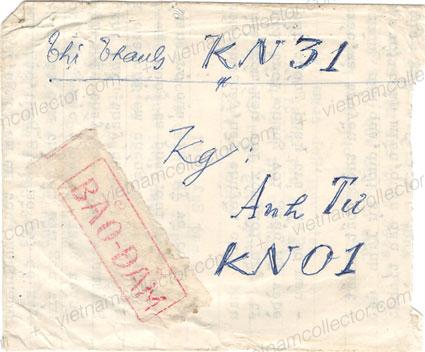


DT (Dien Tin) indicated mail or telegram and G (Gap) urgent/expedited handling. The red hand cachet “DTG” on this letter (ex Munshower) from February of 1975 hence endorses an urgent letter that requests a person with the name Ham Lam, son of Lam Phouc be located and brought in to the party committee headquarters where he will then be transported to Hanoi. His last known addresses were 123 Bing Tay Street and 178/14A Pham Van Tri Street in Cholon, South Vietnam. Manuscript remark on the cover demands a reply by February 13th, 1975, so one day after sending! This very much looks like a court martial proceeding as Ham probably was not transported to Hanoi to receive a medal.


It is unclear if this cover (ex Munshower) is from a Viet Cong or NVA unit but the red hand stamps indicate DTG or Dien Tin Gap (=Urgent Telegram or Mail). The cachet “Yeu Cau Den” (=Date request was received) indicates that the letter was received on January 4th, 1975. 49/B is the official document number. 1451 is the code for a particular individual.

Small adversity cover (ex Munshower) made up from a stolen American paperback novel sent by Mr. Nguyen V. Lai, Unit C1, Reconnaissance Soldier to Mr. 7 and Mr. 9 Sac. The P.B.V.T.N marking stood for Phong Buu Van Tay Nam or Mail Delivery Department of the South West”. This may be reference to the Cambodian mail sorting facility that is thought to have been located in Cambodia near the COSVN post. The use of numbers instead of real names was a secrecy method that allowed persons to remain anonymous to outsiders but still known to insiders. Alternatively the terms gold, silver and bronze were also used for the three top level officials in a unit. The letter translates : To comrades Hung and Sac, we sent a request for food for the unit K56 and Comrade 9 Sac received it and let B7 buy them for K56 with our money. Please send us 14 pair of sandals size 38-40, 120 earrings (SIC) 40 aluminum pots, 30 aluminum buckets, 4 pots size 6 (these were used to make explosives and mines) The persons called Mr. 7 and 9 were likely mid level officials in their unit.
Front

Reverse


Small adversity cover (ex Cartafalsa) made up from a stolen American paperback novel and sent by the same person as above. The P.B.V.T.N marking stood for Phong Buu Van Tay Nam or Mail Delivery Department of the South West”. This may be reference to the Cambodian mail sorting facility that is thought to have been located in Cambodia near the COSVN post. The short letter inside requests a rice shipment to a Vietcong Unit in the field.
Front

Reverse


Not everyone in North Vietnam served in the Armed Forces and carried weapons. A large number of people were required to support the troops fighting in South Vietnam. Many of these people were too old to be placed in the Armed Forces. Some people were not totally trusted because they had relatives in high places in the South Vietnam Government or military. These people supported the war effort by transporting supplies from North Vietnam to South Vietnam , Laos and Cambodia. The Labor Support Service had free mail privileges when they were outside of North Vietnam. The cover below (ex Cartafalsa) was mailed to an NVA or VC unit in the field in South Vietnam from a man in a “Marine Transportation Unit”. This unit was located on the Ho Chi Minh Trail and was responsible for river crossings and the like. It is extremely unusual to see a unit description in a return address and even more so from a civilian worker, as these workers rarely wrote to anyone (if they were even permitted to write).

Guerrilla of Ha Tinh on a NLF sketch published by the Liberation Printing House

Very rare usage (ex Cartafalsa) from the 1964-1966 period before the build-up of U.S. forces. The enemy was just beginning to organize a battlefield mail system to meet demands. Nam Dong is located near Dalat. Later usages would use transfer station locations and not specific geographical locations for security purposes. This envelope originally had an adhesive stamp that was either removed by intelligence services in order to check for any hidden messages under the stamp or it simply fell off as the cover looks like it was immersed in water at some point in time..
 Here are two pristine examples of North-South mail to deployed units in South Vietnam. Addressed to Hop Thu Nr. 92175 and 2563 via Laos into II. Corps. Data circa 1967-68 and captured by U.S. Forces.
Here are two pristine examples of North-South mail to deployed units in South Vietnam. Addressed to Hop Thu Nr. 92175 and 2563 via Laos into II. Corps. Data circa 1967-68 and captured by U.S. Forces.
 Militiaman of Bao Ninh Village. Sketch published by the Liberation Printing House.
Militiaman of Bao Ninh Village. Sketch published by the Liberation Printing House.

Letter (ex Cartafalsa) sent by a female NVA soldier mailed around February 25th, 1968 to a male NVA comrade fighting in South Vietnam. The long number and letters in the upper left are the unit address in North Vietnam while the HT number is in the middle. The last line “Thu goi nap nam” means “somewhere in the South”. The letter was not censored after mailing. Before sealing and application of the postage it would have been read by a unit political officer. February 25th, 1968 was the day U.S. forces captured back the city of Hue from the communist after losing it on January 31st, 1968, the start of the TET Offensive. The cover and letter were found on an NVA body near Hue. The stamp was torn by the South Vietnamese intelligence services in order to check for any hidden messages. The envelope and contents were made from recycled Government forms with the ink handwriting washed off


 This letter (ex Cartafalsa) went from Hai Phong , North Vietnam to an NVA soldier in South Vietnam at “Village South 3”. The letter was initially franked with a North Vietnamese adhesive but the stamp was likely steamed off by the intelligence services in order to check for any hidden messages. Letters from North to South routinely took 3-4 months to be delivered.
This letter (ex Cartafalsa) went from Hai Phong , North Vietnam to an NVA soldier in South Vietnam at “Village South 3”. The letter was initially franked with a North Vietnamese adhesive but the stamp was likely steamed off by the intelligence services in order to check for any hidden messages. Letters from North to South routinely took 3-4 months to be delivered.
 The two covers (ex Cartafalsa) below were taken from a killed Vietnamese located in Corps I. Upon examination of the body a packet of 20 envelopes was found tied to his waist. All letters were addressed to various names at “HT 92178 LT”. Both are routed through Cau Sau, which is thought to be the central mail sorting facility located close to the COSVN Office in Cambodia. The contents of the letters was turned over to the intelligence unit but the ambushers were allowed to keep the envelope as souvenirs. This was basically the only way North-South Mail could be obtained and it explains why these items are so elusive to collectors. The first cover is from a village of Than Hoa in North Vietnam. The second one is from another NVA unit fighting in the South. Both covers are relatively “clean” as they never reached their intended recipients.
The two covers (ex Cartafalsa) below were taken from a killed Vietnamese located in Corps I. Upon examination of the body a packet of 20 envelopes was found tied to his waist. All letters were addressed to various names at “HT 92178 LT”. Both are routed through Cau Sau, which is thought to be the central mail sorting facility located close to the COSVN Office in Cambodia. The contents of the letters was turned over to the intelligence unit but the ambushers were allowed to keep the envelope as souvenirs. This was basically the only way North-South Mail could be obtained and it explains why these items are so elusive to collectors. The first cover is from a village of Than Hoa in North Vietnam. The second one is from another NVA unit fighting in the South. Both covers are relatively “clean” as they never reached their intended recipients.


An anti-aircraft militia group on an NLF sketch published by the Liberation Printing House

Letter (ex Cartafalsa) captured by U.S. forces and sent from Hai Duong in North Vietnam to a NVA unit in the South. The letter was routed through the Cau Sau sorting office. The Car Sau sorting office is thought to have been located close to Committee for South Vietnam (COSVN) in Cambodia but the exact location has not yet been confirmed.

Small “adversity” envelope (ex Cartafalsa)) made from an Eastern European package wrapper and sent on August 10th, 1968 from a Viet Cong Village Defense Force (DPQ) at Huyen Duc Hoa to Long An. Censored on the reverse with manuscript “Kiem Duyet” (=Censored) plus date and notation that the letter contained two pictures. Mekong delta usage. The letter was sold by the son of a U.S. Vietnam Veteran from the 3rd Signal Brigade who was present during the TET Offensive.
Front
 Reverse
Reverse
 The Viet Cong had a system of delivering coded messages that fit in to the rural area of the Mekong Delta region in South Vietnam. In the rural regions, when a person talks about someone they need to make sure that the other person understands exactly who you are referring to as there are only a couple of dozen family names. The person’s job title and location are added after the name to differentiate that person from another with the same name. The cover is addressed as follows:
The Viet Cong had a system of delivering coded messages that fit in to the rural area of the Mekong Delta region in South Vietnam. In the rural regions, when a person talks about someone they need to make sure that the other person understands exactly who you are referring to as there are only a couple of dozen family names. The person’s job title and location are added after the name to differentiate that person from another with the same name. The cover is addressed as follows:
Mr. Nam Quit sends for: Please my friend Chau give this letter to Mr. Chin Chau Xe Loi Xeo Vat and tell him to hand this letter to my wife, Mrs. Tu Phien. Mr. Chin will send this letter to my wife through sampan sailor.
The long Vietnamese name means: (1) One (2) Chin Chau (3) Xe Loi (4) Xeo Vat and (1) Mr. (2) the 9th person in the Chau family (3) whose job is the tricycle driver (4) he lives near the river bend.
This letter (ex Cartafalsa) was seized by members of the ARVN 31st Infantry Division in the Mekong Delta.

Most mail without a return address is difficult if not impossible to ascertain origin. This cover (ex Cartafalsa), however, without any real return address, can be identified as having come from a Viet Cong controlled village in South Vietnam. The partial contents, which was written on the inside of the envelope, states “U.S. and illegal (SVN troops) killed many of our brother citizens. They mortared us while our citizens were catching fish in the rice paddy.” While without date, this cover is from before January , 1968. At that time, the VC rose up to overthrow the SVN Government and in the process were decimated and pretty much eliminated as a fighting force. The North Vietnamese Army took over the war and did not participate in local activities such as farming and fishing.

 The cover below (ex Cartafalsa) was found among the personal possessions of a U.S. Vietnam veteran. By analyzing the address this cover can be identified as having been addressed after May 23rd, 1972. On this date, President Nixon ordered the bombing of Hai Phong and Hanoi and included non-military targets. The cover is addressed to Nguyen Dinh Chuoi, home Nr. 19, Hong Bang Rebuilt Section (Xom Kien Thiet) Section 1, Hai Phong. The reference to “Rebuilt Section” is a reference to the reconstruction done after the bombings of 1972. The only other time this reference was used was during the 1945 August Revolution, against the French, which resulted in the naval bombardment of Hai Phong. Clearly this cover is not from 1945. The cover most likely dates from the end of 1973 or 1974 so towards the end of the war.
The cover below (ex Cartafalsa) was found among the personal possessions of a U.S. Vietnam veteran. By analyzing the address this cover can be identified as having been addressed after May 23rd, 1972. On this date, President Nixon ordered the bombing of Hai Phong and Hanoi and included non-military targets. The cover is addressed to Nguyen Dinh Chuoi, home Nr. 19, Hong Bang Rebuilt Section (Xom Kien Thiet) Section 1, Hai Phong. The reference to “Rebuilt Section” is a reference to the reconstruction done after the bombings of 1972. The only other time this reference was used was during the 1945 August Revolution, against the French, which resulted in the naval bombardment of Hai Phong. Clearly this cover is not from 1945. The cover most likely dates from the end of 1973 or 1974 so towards the end of the war.

A mid level guerrilla leader, And Sau Vang (referred to also as Sir #6 Vang) reports late in the war (March 8th, 1974) on the progress of the new guerrilla base close to Saigon. He details the construction and some problems. He is requesting assistance from the Chinese People’s Committee and other NLF units. He also complains about getting too little support from the people from Long An Village. The cover (ex Munshower) has a manuscript QT (=Quan Thu or Military Mail). Ba Duc was located in B3 (Long An Village). It was one of the jump off bases for the final assault on Saigon on April 30th, 1975.



This small Vietcong guerrilla cover (ex Munshower) contained a roster from April 4th 1975 of Vietcong Unit 16 from Down Vi who survived the critical battle of Binh Duong which took place outside of Saigon. The roster is titled “List of Comrades in Unit 14 who came back alive from the victory at Binh Duong”. One of the survivors listed on the paper is the sender of the list. The homemade battlefield cover is addressed to “Mr. Nr. Three”. The bottom of the cover bears the notation “Let Mr. Nghi deliver this in person”. Mr. Nghi is also listed as a survivor of the battle. Historical document that is connected to the final battle for Saigon in 1975.


Small letter (ex Munshower) from December 29th, 1974 “Dear Brother #2 Vu, I haven#t heard anything about you until I met comrade Thuy in Fall 1967. He said that you are attending college- oh God that is unbelievable! I also heard that you came back with a victory. In 1971, I sent to meet Brother 7 Beard to get more information. Then I received a letter from Brother 6 Gold that said you said hello to me. Vu, we are the victors after years of fighting hard and a lot of success. You have suffered more than me since you are in jail. Please accept our honor. The friends with two generations that fought against the American troops. We have not seen each other for a long time and we have missed a lot to talk about. I remember the first time I met you at Jungle U Minh. At that time, the “dance supervisor” who went to the same school with me in Hanoi was there. The second time we met was at the jungle of Tay Ninh. That time our hair was still jet black. If we meet another time, may be we both will have grey hair. Life still goes on. Are you okay now? Do you have a new assignment? Let me know what your duties are now. As for me I was at the protest in Mau Than at Ba Ria Long Khanh. After that , I was at a pacifist protest against American troops. The Ut Can protest against violation of the peace treaty in 1972 until 1973. All of us are still here and doing whatever we can to influence the enemy now, who are the Northerers that have moved to the South and the minority. Now I have been assigned to MT TI. II am going to let Brother #3 know the details. I think maybe you already know it. I am still as before, but my eyes now require glasses with 25 degrees. Other than that, I am still healthy.I can still fight against our enemies- American troops and Southern troops for 10 or 15 years. I want to let you know that my son is grown and may join in our fight against the economy. He is married with a young son. Please say hi to Brother #8 Peace, Brother 6 Quang, Miss Hua Vang, Miss Lien, Miss Dung and the others. Also say hi to Brother 4 Minh, Brother 6 New, Huynh Nghi, 3 Mountains, and the others. Written by my hand. 29/12/74 5 Binh” This is a nice example of how code names were used in order to protect the exact identity of fellow soldiers. Also “going to college or university” was a synonym for going to jail.



Small folded letter (ex Munshower) from towards the end of the war (February 25th, 1975) sent by Chau Van Khi (Hom Thu Nr. 3423) in Phuoc Long sent to a Hong Liem of organization Hoa Van (Chinese Resistance).

 Small letter (ex Munshower) from February of 1975. “Dear Uncle #3, I just wanted to let you know that on this 3rd evening of the TET Festival, Mother K Dan brought her daughter to us. Uncle #4 met with them and interviewed them and asked them for the procedures on how to obtain a recommendation letter. However, after reviewing her background, there were no documents about her even though she is still an active member of the Communist Party. Her mother said please give her a chance to start over. According to CQ she is now at B2. I wasn’t there when this happened, but Uncle #4 told me. Please let us know how you want us to resolve this matter? We will follow your orders. We wish you a Happy New Year with good health.” The contents indicates how essential political purity was for any appointments in and outside of Government.
Small letter (ex Munshower) from February of 1975. “Dear Uncle #3, I just wanted to let you know that on this 3rd evening of the TET Festival, Mother K Dan brought her daughter to us. Uncle #4 met with them and interviewed them and asked them for the procedures on how to obtain a recommendation letter. However, after reviewing her background, there were no documents about her even though she is still an active member of the Communist Party. Her mother said please give her a chance to start over. According to CQ she is now at B2. I wasn’t there when this happened, but Uncle #4 told me. Please let us know how you want us to resolve this matter? We will follow your orders. We wish you a Happy New Year with good health.” The contents indicates how essential political purity was for any appointments in and outside of Government.

 Letter (ex Munshower) sent by Han Truong Vu Nr. 4463 in Saigon to Hom Thu F9229 Cholon. The red manuscript “R” is a censor mark. “Dear Mr. Ba Duc: A wish of Vu to Mr. Ba Duc’s business. He wants to come back there to gather with all friends from 10 years ago. But is restricted in his place in the New Year. Vu asks people in T4 to help him take his wife and children to Saigon and then from Saigon to the liberated area in the New Year. If Ba Duc has any information about that, please let him know immediately.” At the end of the letter he wishes good health for the recipient and his business.
Letter (ex Munshower) sent by Han Truong Vu Nr. 4463 in Saigon to Hom Thu F9229 Cholon. The red manuscript “R” is a censor mark. “Dear Mr. Ba Duc: A wish of Vu to Mr. Ba Duc’s business. He wants to come back there to gather with all friends from 10 years ago. But is restricted in his place in the New Year. Vu asks people in T4 to help him take his wife and children to Saigon and then from Saigon to the liberated area in the New Year. If Ba Duc has any information about that, please let him know immediately.” At the end of the letter he wishes good health for the recipient and his business.

 Tiny envelope (ex Munshower) that contained a very long letter sent by Car Dong Chi (=Comrades) to the National Liberation Front Leadership Agency. Letter yet to be translated.
Tiny envelope (ex Munshower) that contained a very long letter sent by Car Dong Chi (=Comrades) to the National Liberation Front Leadership Agency. Letter yet to be translated.





North-South letter (ex Munshower) sent on March 2nd, 1974 from Lang in Hanoi to Comrade Ngo Duc (same as Ngo Lien): Remark “Please send directly to destination. Thank you.” Son of NLF official in South wants Duc to write on behalf of the Government for the care he gave him. He relates information about his time spent as a student in China and wishes him good health. A letter in Chinese language was also included. The envelope gives both, the code and cover name used by Duc. This was a security breach that allowed the names to be cross-referenced against possible Vietcong suspects and Duc’s identity might have become known to the South Vietnamese.




Translation of the letter in Chinese language:
Wu Fa commrade,
it has been a long time no seeing you, missing you very much. A while back, your wife and your child visited the south. They must have been aware of the situation here, so I am not talking about it more. I would only wish you good health and make greater contribution to the revolution.
While expressing my greeting to an old friend, here are some recent changes:
Mr. and Ms. Lin Fu have retired. They now live in Shanghai. Tian Ru works at the library of the Beijing Institute of Foreign Languages. San Bao Can was promoted two levels, becoming a Class 2 Committee Member. Lin Zhao was promoted and has moved to Hanoi. She works very well with Zhuang Yong, the editor-in-chief. Last year, Qi Yuan sent the remains of his mom to her hometown. Now he is the deputy chief of the Chinese Association in Hanoi. Han Guan has retired. Ding Li now works at Guang Dong People’s Publishing, makes YMB100 a month. Pu Zhao has retired. He and his wife and the Fang Zhao and his wife have applied to return to China. Ling Zhen is in Sichuan, working in Chongqing University. Zhou Aihuan works in the 5th Middle School in Guilin. Si Bo and his wife work in Jiangxi at the Nachan University. Zhang Zhao is now the deputy editor-in-chief of the New Vietnam Chinese Newspaper, where Huang Wei is the general secretary. Pu Fa and Wu Han are competent editors. Zhang Guo has been promoted to Class 5 Cadre. Tu Feng is now in Zhengzhou as the photographer/reporter of Henan Daily. Liao Shen has been asked to retire. Ke Da and his wife are in a Shantou factory. Cheng Du stays at home due to long-term sickness. Guan Ting has been promoted to the deputy chief of Naval Defence United Front for number of years now. Ji Feng is deputy chief of Naval Defence Chinese Association. Fe Ying has been married to Cai You of United Newspaper. In one word, there are many changes with people, and everyone is happy with where they are. New people have come forward in all departments. The market for Chinese publication is quiet, there are ver few activity, no need to say more here. Other things are similar, no more to talk more.
Along with letter are three health guidebooks. Especially, hand exercise can help the health.
Best regards to all of my relatives and friends
Small letter (ex Munshower) from February of 1975 that contained a copy of the “Free Peoples Chinese News” sent by a Mr. Six Vang to Hoa Van Chinese People’s Committee Group. These local guerrilla propaganda was written and edited in China by the Information Ministry and sent to Vietnam where they were locally reproduced and distributed. This documents the intense logistical support the Peoples Republic of China provided to North Vietnam throughout the war. This particular sample may be an original copy sent directly from China as it is printed on rice paper which was rarely used in Vietnam. One of two known copies (only first of four pages scanned).



- The header reads “Liberation Journal”
- The box on the right reads “Jan 1975, Issue 19, SheTee national liberational frontier propaganda department”. The translation “SheTee” is purely made up by the translator based on the sound of the Chinese. It is the name of a place but it is not know exactly what this place is. In Chinese the word is usually used to name a famous beef dish. That said, SheTee appears multiple times in this journal.
- The subtitle reads “SheTee people demand helping the hungry, freedom of speech, peaceful coexistence of different ethnic groups, anti-corruption, anti-HuKou system, anti drafting/blackmailing. The fighting for their own benefit is gaining momentum.
The bottom part of the page reads:
Only by overthrowing the government of Nguyen Van Thieu can real peace be achieved. To realize the Paris Peace Accords, Saigon needs a new government that plans to execute the Parisk Peace Accords.
The vertical large font reads “anti-US and down with Nguyen Van Thieu movement is developing widely and deeply”
Very rare, still sealed Trail Mails (ex Munshower) from the same correspondence that were sent from Han Truong Vu Nr. 4463 Group 2 to Comrade Nghi F9229 at village B3 and from Han Truong Vu Nr. 4463 to Mr. #6 Vang and Mr.#4 Ninh at F9229.


Letter (ex Munshower) sent by D.Son to Mr. Ba: “Dear Mr. Ba, I request that, on 1st of each month I will see Mr. Chin. From the 2nd to the 5th I will leave my goods at Mr. Tu’s place. From the 2nd to the 5th you plan your goods and let Thanh bring to Mr. Tu. In the future, I take advantage of one time each half month possible. At 1/3 I start to take goods from Mr. Chin. Remember the goods must be in a square shape not rectangular.” Clearly this letter is written in code and probably deals with a military supply shipment.

 Small letter (ex Munshower) sent on February 16th, 1975 from Long An Village (known as location B3 at the time) to Ba Cay Hom Thu N3423.
Small letter (ex Munshower) sent on February 16th, 1975 from Long An Village (known as location B3 at the time) to Ba Cay Hom Thu N3423.


 This document (ex Munshower) is an official mission summary (So Ket) for Mission Team #2 and gives details about the proselytizing the Chinese residents of Hoa Hiep in regards to the decision of the People’s Revolutionary Committee of Tay Ninh Province decision of May 6th, 1974. Complaints and questions raised by Chinese residents of Hoa Hiep Village. Preliminary activity and results of the mission. Letter is dated June 4th, 1974 and signed by Mission Leader (Cong Tan) Tran.
This document (ex Munshower) is an official mission summary (So Ket) for Mission Team #2 and gives details about the proselytizing the Chinese residents of Hoa Hiep in regards to the decision of the People’s Revolutionary Committee of Tay Ninh Province decision of May 6th, 1974. Complaints and questions raised by Chinese residents of Hoa Hiep Village. Preliminary activity and results of the mission. Letter is dated June 4th, 1974 and signed by Mission Leader (Cong Tan) Tran.





Below is a set of three documents (ex Munshower) that concerns the capture of two guerrilla women, who were on their way from a COSVN sub-office in Cambodia en route to the Saigon area on April 17th, 1974. The deposition, records in their own words, how they left Karache and traveled by night to Sa Long., then moved on to Sa Mat where they remained in Mrs. Lan’s safe house for several days. Later they traveled to Thiet Noon where they remained for 10 days. When they heard that their mission had been cancelled, they decided they would sell goods in a Government controlled area and did this successfully until captured by Government forces. Upon rejoining the NLF they were held for interrogation because they had left the secure COSVN area without proper permission, forged Government documents and travel permits. The two smaller documents are lists of immediate family members who were investigated and interrogated for possible connections to the “enemy” Government. The women’s names were Phan Hua To and Lan Quach Hieu. Quach was a university student wo had been born in China. Interesting documentation of a court martial.




 Small folded letter (ex Munshower) mailed on April 5th, 1975, just a few weeks before the end of the war, respectful addressed to Father Ba Men. “I would like to report serious problems at the Ta Nong School. There are not enough teachers, one killed, Mr. Ly Don quit…. I have discussed it with the local committee…. Only one selection. Mrs. Vuong Le Lien cousin of Mrs. Nguyen Na who is a teacher in Loc Ninh…. we must have more, maybe allow Cuc and Tanh to teach for one semester…I am waiting for your ideas.” Manuscript “Examined-Ok”.
Small folded letter (ex Munshower) mailed on April 5th, 1975, just a few weeks before the end of the war, respectful addressed to Father Ba Men. “I would like to report serious problems at the Ta Nong School. There are not enough teachers, one killed, Mr. Ly Don quit…. I have discussed it with the local committee…. Only one selection. Mrs. Vuong Le Lien cousin of Mrs. Nguyen Na who is a teacher in Loc Ninh…. we must have more, maybe allow Cuc and Tanh to teach for one semester…I am waiting for your ideas.” Manuscript “Examined-Ok”.

 This document (ex Munshower) dated April 20th, 1974 issues new guidelines concerning the enforcement of NLF/Vietcong policy and actions in regards to politics, education, moral conduct and actions of all NLF/PAVN, political cadre and staff. “All interactions will be revised and watched by the party and any negative manifestations of bad behavior will be dealt with by the People’s Committees. All of the above will be required to volunteer in building the base in the liberated area between Binh Phuoc and Tay Ninh.Committee of the KBN (COSVN) Ta Ninh is sending this official notice of instructions #05/TC.74 to base committee T1.”
This document (ex Munshower) dated April 20th, 1974 issues new guidelines concerning the enforcement of NLF/Vietcong policy and actions in regards to politics, education, moral conduct and actions of all NLF/PAVN, political cadre and staff. “All interactions will be revised and watched by the party and any negative manifestations of bad behavior will be dealt with by the People’s Committees. All of the above will be required to volunteer in building the base in the liberated area between Binh Phuoc and Tay Ninh.Committee of the KBN (COSVN) Ta Ninh is sending this official notice of instructions #05/TC.74 to base committee T1.”



 Rare guerrilla poetry (ex Munshower) about the war, weapons an attach in September of 1973 sent to a friend and trusted ally. Not fully translated but the writer mentions AK 47 and rocket propelled grenade B-406.
Rare guerrilla poetry (ex Munshower) about the war, weapons an attach in September of 1973 sent to a friend and trusted ally. Not fully translated but the writer mentions AK 47 and rocket propelled grenade B-406.




Small letter (ex Munshower) sent in June of 1974 by Nguyen Van Ri to B.B.V.T4 Ban Buu Van T4-Mail Transportation Committee T4 (Gia Dinh). Received by Nhan: Le Van Thach. The letter discusses the current political and military situation. Clear mail routing addresses were rarely ever used as this compromised security.



 Letter (ex Munshower) from the Army Command Committee 45 to the Committee Headquarters Command South containing operation instructions (only one of four pages scanned):
Letter (ex Munshower) from the Army Command Committee 45 to the Committee Headquarters Command South containing operation instructions (only one of four pages scanned):
I Establishment of operating instructions
II Establishment of getting experiences and estimating the result of operating the instructions
III The steps of operating the following plan
The document is dated December 17th, 1974 and signed by Huynh Trung Nam.

 Military letter (ex Munshower) sent on February of 1974 and sent by Chau N. Minh asking for clarification of, and additional information as to the location and construction of the new secret base in the Liberated Areas (Tay Nong Village in Tay Ninh Province).
Military letter (ex Munshower) sent on February of 1974 and sent by Chau N. Minh asking for clarification of, and additional information as to the location and construction of the new secret base in the Liberated Areas (Tay Nong Village in Tay Ninh Province).

 Actual photograph (ex Munshower) of new Vietcong recruits trained in a secret base area in South Vietnam
Actual photograph (ex Munshower) of new Vietcong recruits trained in a secret base area in South Vietnam
 This is a quarterly activity report from February of 1975 (ex Munshower) to committee headquarters written by Mr. #3, head of the Hoa Van committee and it contains details on: I Why no report was sent for the prior quarter. II A plan to be submitted in response to the past study of the problems encountered by local Chinese residents. III The unauthorized arrival of Chinese people from Loc Ninh. IV The results of recent NVA and Vietcong operations. V The final vote of the parent/pupil board. VI Sender asks if the important letter from Mr. Ngo Vinh has arrived yet. VII Names of people asking to join the NLF:
This is a quarterly activity report from February of 1975 (ex Munshower) to committee headquarters written by Mr. #3, head of the Hoa Van committee and it contains details on: I Why no report was sent for the prior quarter. II A plan to be submitted in response to the past study of the problems encountered by local Chinese residents. III The unauthorized arrival of Chinese people from Loc Ninh. IV The results of recent NVA and Vietcong operations. V The final vote of the parent/pupil board. VI Sender asks if the important letter from Mr. Ngo Vinh has arrived yet. VII Names of people asking to join the NLF:




 Small folded letter (ex Munshower) sent in January of 1975 from Cu Chi to Saigon. Cu Chi was the site of a large Vietcong underground base that consisted primarily of underground tunnels and rooms (including hospitals and kitchens). The letter reveals that an old and gravely ill ex-Viet Minh fighter who, despite the fact that he crossed over to the Government many years ago, states that even though he is growing weaker and sicker, he will remain alive long enough for him to follow the revolution to the great victory. He then reminisces about the years he and Mr. Ba Duc spent fighting and working for the revolution. He regrets now being on the outside because of his earlier mistakes.
Small folded letter (ex Munshower) sent in January of 1975 from Cu Chi to Saigon. Cu Chi was the site of a large Vietcong underground base that consisted primarily of underground tunnels and rooms (including hospitals and kitchens). The letter reveals that an old and gravely ill ex-Viet Minh fighter who, despite the fact that he crossed over to the Government many years ago, states that even though he is growing weaker and sicker, he will remain alive long enough for him to follow the revolution to the great victory. He then reminisces about the years he and Mr. Ba Duc spent fighting and working for the revolution. He regrets now being on the outside because of his earlier mistakes.

 U.S. Military map (ex Munshower) of the Ch Chi and Saigon area with manuscript and hand stamp additions.
U.S. Military map (ex Munshower) of the Ch Chi and Saigon area with manuscript and hand stamp additions.
 Small letter (ex Munshower) sent by Mr. 2 Binh to Mr. Ba in June of 1974. The letter deals with a re-organization and transfer of some cadres because the leadership is preparing some changes. This is apparently a sensitive topic as the writer emphasizes confidentiality and informs the recipient that he will bring a copy of his letter to the meeting order to prove his identity. Also there is a request to retain Mrs. Banh Duong for the reception committee as she speaks good English. The writer also speaks about a case involving Mrs. Lien (Tu Lien). She apparently had a love relationship with an ex police man. The relationship appears to be strong so that she is ignoring the “organization”. There were strong concerns about security. A letter that was sent by Mrs. Lien to her lover, without informing the “organization” is enclosed as evidence.
Small letter (ex Munshower) sent by Mr. 2 Binh to Mr. Ba in June of 1974. The letter deals with a re-organization and transfer of some cadres because the leadership is preparing some changes. This is apparently a sensitive topic as the writer emphasizes confidentiality and informs the recipient that he will bring a copy of his letter to the meeting order to prove his identity. Also there is a request to retain Mrs. Banh Duong for the reception committee as she speaks good English. The writer also speaks about a case involving Mrs. Lien (Tu Lien). She apparently had a love relationship with an ex police man. The relationship appears to be strong so that she is ignoring the “organization”. There were strong concerns about security. A letter that was sent by Mrs. Lien to her lover, without informing the “organization” is enclosed as evidence.

 Letter (ex Munshower) written by Trung to Ba Duc in Village #3 is a reply to a previous letter by Mr. Duc. “I can tell you that in January, 1975 Mr. #3 Son left and I do not know for sure but I think he has been caught by the enemy unit…he had an expired travel certificate so may be that is why he was caught…Mr. #4 Minh allowed him to go and let him keep his weapon #K54 (K usually referred to an M-16 Rifle) and he went without permission.”
Letter (ex Munshower) written by Trung to Ba Duc in Village #3 is a reply to a previous letter by Mr. Duc. “I can tell you that in January, 1975 Mr. #3 Son left and I do not know for sure but I think he has been caught by the enemy unit…he had an expired travel certificate so may be that is why he was caught…Mr. #4 Minh allowed him to go and let him keep his weapon #K54 (K usually referred to an M-16 Rifle) and he went without permission.”

 A female guerrilla Nam Vinh (5 Vinh) writes a long letter (ex Munshower) to Miss Chi Lam asking for medical and first aid information she needs for the sick and wounded Vietcong. “5 Vinh” is with a main force unit at Hom Thu 9451 moving towards Saigon. The letter was posted on March 11, 1975. This adversity cover was made from a page of a Tay Ninh “National Enquirer” type of periodical sent to a military address near Saigon.
A female guerrilla Nam Vinh (5 Vinh) writes a long letter (ex Munshower) to Miss Chi Lam asking for medical and first aid information she needs for the sick and wounded Vietcong. “5 Vinh” is with a main force unit at Hom Thu 9451 moving towards Saigon. The letter was posted on March 11, 1975. This adversity cover was made from a page of a Tay Ninh “National Enquirer” type of periodical sent to a military address near Saigon.


 Postcard of a female guerrilla fighter issued by the National Liberation Front (NLF).
Postcard of a female guerrilla fighter issued by the National Liberation Front (NLF).
 Guerilla adversity cover (ex Munshower) sent by Huynh Bo on January 12th, 1975 to Sau Vang at Van Fong (office) F9229. Received on the same day. “Comrade Sau Vang, I am excited that I have been given a new mission although I see there will be many difficulties….I will overcome them. There is difficulty with the situation of Gai Gai’s working team…because our brothers do not have direct contact with the other organizations or the front leader, we do not want to restrict their work because the drinking and the fighting problems of brother Hing Was, but he says many wrong things. He is untrustworthy…and has many weaknesses…. he hates many groups and this will cause fights. Gum Wa is active but he is not smart, he must return to your company for more training. Lien assigns much of his work but his men do not work seriously…the letter continues about local guerrilla issues.”
Guerilla adversity cover (ex Munshower) sent by Huynh Bo on January 12th, 1975 to Sau Vang at Van Fong (office) F9229. Received on the same day. “Comrade Sau Vang, I am excited that I have been given a new mission although I see there will be many difficulties….I will overcome them. There is difficulty with the situation of Gai Gai’s working team…because our brothers do not have direct contact with the other organizations or the front leader, we do not want to restrict their work because the drinking and the fighting problems of brother Hing Was, but he says many wrong things. He is untrustworthy…and has many weaknesses…. he hates many groups and this will cause fights. Gum Wa is active but he is not smart, he must return to your company for more training. Lien assigns much of his work but his men do not work seriously…the letter continues about local guerrilla issues.”



Letter (ex Munshower) sent by a guerrilla on March 21st, 1975 from Hom Thu 5.226. Censured (K.Duyet) by Ban on Mach 22nd (see note on lower left). Received Ba Mr. #6 on March 30th. Guerilla asks the leader for more time to return the medical text book he has been using for the treatment of wounded guerrillas and sick civilians. It was technically required that all guerrilla and military mail be censored by a party cadre but this was not strictly enforced. The censor was to sign his name and date on the envelope at the lower left corner. In addition the words “Kim Soat” (=inspected) or Kiem Duyet (=examined) had to be applied. Prior to the change in mail marking abbreviations and postal acronyms in 1971, all of this information had to be written in the upper left corner. This practice caused much confusion as much of the undeliverable mail was returned to the censor rather than the sender. A census of the few surviving guerrilla covers shows only about 5-10% of all covers were in fact censured.



Local Army Command Board (Uy Ban Quan Quan) official hand cachet used as BUU DIEN or government official postpaid free frank. The Army Command Boards were set up within the first week a larger town was captured and they became the immediate legal and judicial authority for all matters not related to the conduct of war or revolutionary provisional activities. The small circular cachet indicates which district or ward was administered by a particular board. This sample, which deals with the appeal of a woman that wants to emigrate to France but the Army Command Board says that this is not under their jurisdiction and is under jurisdiction of the People’s Party Committee, is from October, 1975, so shortly after the end of the war. Rare HOA/TOC) cachet indicating Urgent/Flash.


A very similar cover from the same Army Command Board that was ultimately returned to the sender. The contents from October 24th, 1975 deals with the complaint of a family whose home was confiscated by the Revolutionary Committee. In typical bureaucratic fashion the Board refers the complainant to District 5 Revolutionary Committee for further resolution.


Registration Nr. 200100

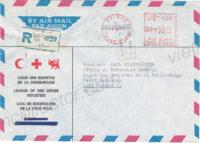
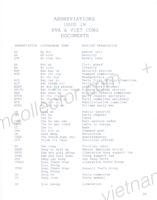
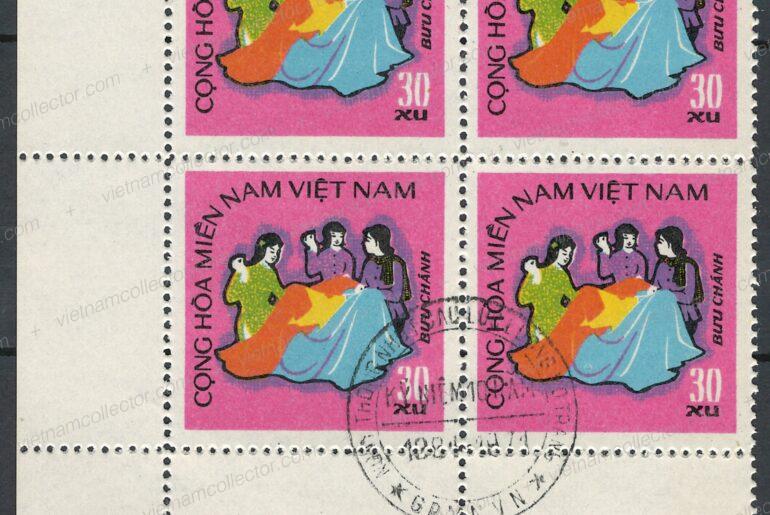
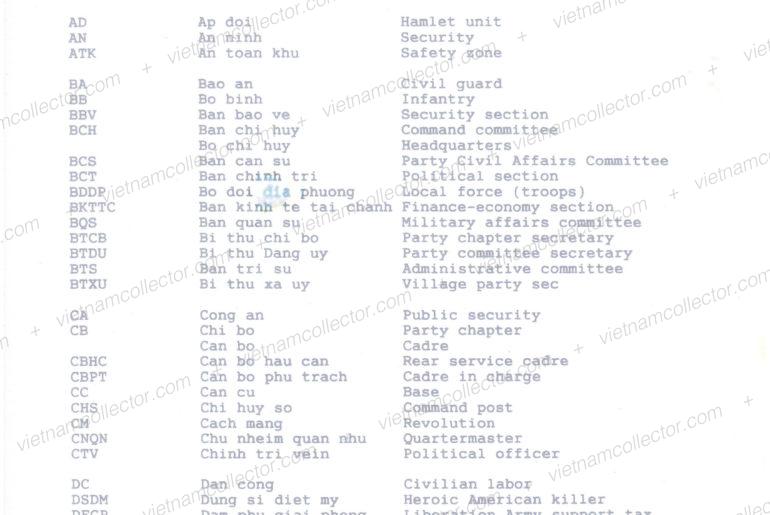
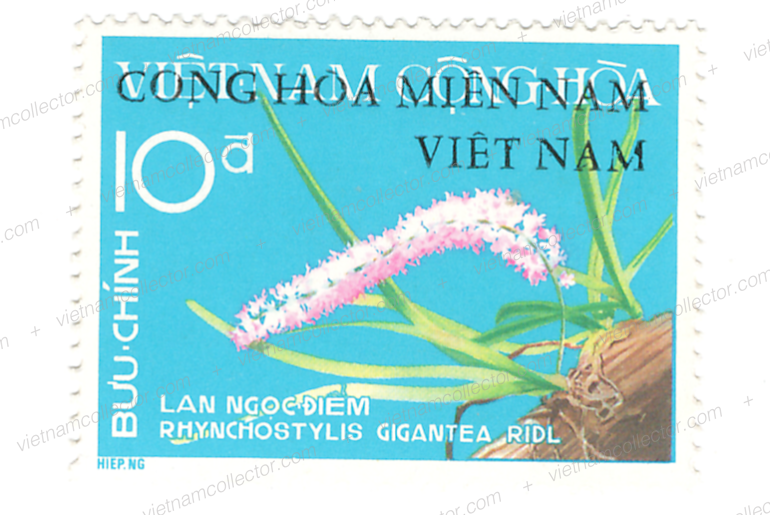
Comments are closed.